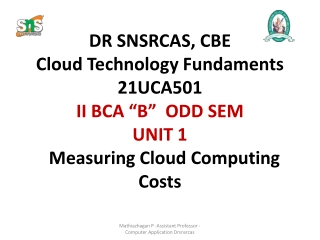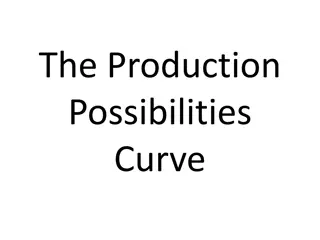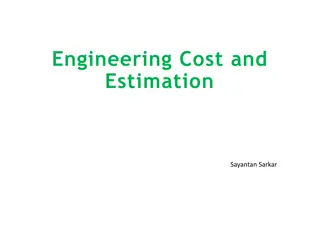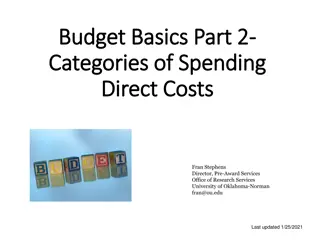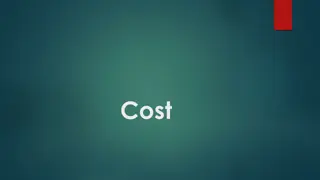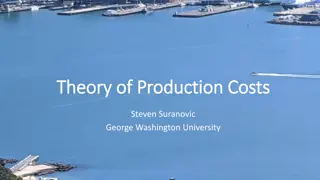Measuring Cloud Computing Costs
Understand the costs of cloud computing deployments, including unit costs, additional resource costs, and comparing with private clouds.
1 views • 5 slides
Guidelines for Direct Costs in H2020 Funding
Direct costs in Horizon 2020 funding must be accurately measured and attributed only to the specific action being funded. Costs must be directly linked to the implementation of the action and supported with sufficient evidence. It is crucial to avoid errors in other direct costs, ensure proper recor
0 views • 26 slides
Cost Accounting Standards for Determining Transportation Costs
Understanding the importance of transportation costs in procurement and distribution, this guide outlines the standards for determining average costs, separation of transportation costs in accounting records, objectives for maintaining cost uniformity, components of transportation costs, and treatme
0 views • 11 slides
Cash Flow Estimation and Risk Analysis Overview
This content delves into the principles of cash flow estimation and risk analysis in project evaluation. It covers learning objectives, incremental cash flows, treatment of financing costs, sunk costs, opportunity costs, and externalities in financial decision-making. Understanding these concepts is
1 views • 35 slides
Essential Considerations for Capital Investment Decisions
Making capital investment decisions involves evaluating relevant cash flows, considering sunk costs and opportunity costs, and assessing side effects. By focusing on incremental cash flows and excluding sunk costs, while considering opportunity costs and side effects, businesses can make informed de
0 views • 29 slides
Understanding Production Possibilities Frontier and Opportunity Cost
The production possibilities frontier illustrates all possible combinations of two products, showcasing the concept of scarcity and opportunity cost. Along the frontier, opportunity costs are not constant due to the Law of Increasing Costs. Efficient production occurs on the frontier, while points i
0 views • 13 slides
Understanding Production Possibilities Curve and Economic Growth
The Production Possibilities Curve illustrates trade-offs in an economy producing two goods, showing possible combinations using available resources. Efficiency on the curve means no way to make some better off without others worse off. Opportunity cost is the given-up production when increasing one
0 views • 5 slides
Grant Management Flexibility under Horizon 2020 During COVID-19
Grant management under Horizon 2020 during COVID-19 requires maximum flexibility with eligibility of costs incurred, force majeure clause usage, and flexibility in actual personnel costs. Teleworking costs are eligible, and personnel costs can be adjusted for exceptional circumstances. Travel costs
1 views • 12 slides
Understanding Administrative Costs in Grant Management
Administrative costs are essential for managing grants effectively. Learn about the difference between direct and indirect costs, and why tracking and reporting accurately is crucial to avoid disallowed costs. Explore the definition, classification, and significance of administrative costs in grant
0 views • 22 slides
Understanding Activities Delivery Costs and Program Administrative Costs in CDBG Programs
Exploring the allocation of staff costs between Activities Delivery Costs (ADCs) and Program Administrative Costs (PACs) in Community Development Block Grant (CDBG) programs. ADCs cover non-profit staff expenses for carrying out eligible activities, while PACs include costs for planning, general adm
1 views • 10 slides
Understanding the Costs of Inflation and Its Impact on Purchasing Power
Inflation is a crucial economic phenomenon with both winners and losers. While inflation itself doesn't necessarily reduce real purchasing power, it leads to various costs such as shoeleather costs, menu costs, and unit of account costs. These costs emerge due to the changing dynamics of prices, wag
0 views • 16 slides
Understanding Overhead Accounting and Allocation Process
Overhead accounting involves allocating and apportioning overhead costs to different departments or cost centers in a company. This process includes dividing cost centers into production and service departments, assigning overhead costs accurately, and distributing common overhead costs proportionat
0 views • 18 slides
Understanding Costs for Defendants in Legal Proceedings
This article provides detailed information on the costs involved for defendants in legal cases, including the starting point for cost allocation, costs at different stages of the legal process, and considerations for recovery of costs. It covers aspects such as costs at the pre-action stage, costs a
2 views • 54 slides
Overview of New Civil Procedure Rules on Costs: CPR Parts 58 & 59
The new Civil Procedure Rules (CPR) Parts 58 & 59 introduce changes in the assessment and taxation of costs in legal proceedings. Detailed assessment replaces taxation, standard basis, fixed costs, and more defined, with new definitions and procedures outlined. Order 59 expands the powers to tax cos
0 views • 22 slides
Understanding Engineering Costs and Estimation Methods
This informative content delves into the concept of engineering costs and estimations, covering important aspects such as fixed costs, variable costs, semi-variable costs, total costs, average costs, marginal costs, and profit-loss breakeven charts. It provides clear explanations and examples to hel
0 views • 33 slides
Understanding Qualified Opportunity Zones Tax Benefits
Qualified Opportunity Zones (Opportunity Zones) offer tax incentives to investors who reinvest capital gains in designated low-income communities. By utilizing Qualified Opportunity Funds (QOF), investors can benefit from capital gains deferral, partial gain exclusion, and full gain exclusion on app
0 views • 12 slides
Understanding Budget Basics for Comprehensive Budget Development
Components necessary for comprehensive budget development include categories of spending like direct costs, personnel costs, and facilities & administrative costs. Budget construction may vary by sponsor, but a detailed budget is required at submission. Personnel costs cover various types of employe
1 views • 19 slides
Understanding Costs in Business: Types and Significance
Costs in business play a crucial role in determining profitability and decision-making. This article explores various types of costs such as direct, indirect, fixed, and variable costs, along with their definitions, uses, and impact on business operations. Understanding these costs is essential for
0 views • 13 slides
Understanding Marginal Costing in Cost Accounting
Marginal Costing is a cost analysis technique that helps management control costs and make informed decisions. It involves dividing total costs into fixed and variable components, with fixed costs remaining constant and variable costs changing per unit of output. In Marginal Costing, only variable c
1 views • 7 slides
Understanding the Concepts of Trade and Comparative Advantage
Explore the fundamental concepts of trade, specialization, absolute and comparative advantage, opportunity costs, and more. Learn how nations can benefit from trade, even without absolute advantage, and the importance of making choices based on opportunity costs. Discover how differing opportunity c
0 views • 28 slides
How to Fill Out a Nursing Assistant Certification Reimbursement Request Form
Detailed instructions on filling out Form 06-123 for Nursing Assistant Certification (NAC) reimbursement requests. Sections covered include Provider Information, Direct Care Costs, Operating Costs, Total Costs, and Provider Authorization. The form requires manual entry of some totals and provides au
0 views • 16 slides
Analysis of 2021 Marginal Generation Costs for San Diego Gas & Electric
The analysis presents the 2021 Marginal Generation Costs methodology filed by San Diego Gas & Electric in April 2016 for the Time-of-Use (TOU) OIR Workshop. It includes forecasts for Marginal Energy Costs (MEC) and Marginal Generation Capacity Costs (MGCC) for the calendar year 2021, based on market
0 views • 6 slides
Understanding Overhead Costs and Their Importance in Business
Overhead costs play a crucial role in cost allocation and management within an organization. These costs, which include indirect expenses such as labor, materials, and services, cannot be directly linked to specific units of production. Instead, overhead costs are apportioned and absorbed using vari
0 views • 16 slides
Understanding Costs, Revenue, and Profit in Economics
Cost is the expenditure on goods or services, including opportunity cost. It can be explicit or implicit. Measuring opportunity cost involves factors of production and sacrifices. Economic profit considers opportunity cost while accounting profit does not. Production in the short run depends on inpu
0 views • 53 slides
Project Cost Estimation for Microgrid Equipment and Installation
This module delves into estimating project costs for microgrid equipment, including procurement, installation, design, and engineering. It covers categories such as installation costs, design and engineering costs, overhead costs, and contingency costs, to provide a comprehensive understanding of es
0 views • 18 slides
Understanding Migration Costs in Low-skilled Labor Migration
This content delves into the work of KNOMAD and The World Bank in measuring migration costs for low-skilled labor migration. It outlines the objectives, phases, and methodologies used to assess various costs incurred throughout the migration cycle, such as compliance costs, transportation expenses,
1 views • 21 slides
Guidelines on Allowable Costs and Related Parties in Long-term Debt Training
Explore guidelines on allowable costs and transactions with related parties in long-term debt training programs. Learn about costs paid to other agencies, examples of allowed costs, and costs not allowed. Gain insights into the XI-Q Bond Agency Guide and upcoming training sessions. Have questions? F
0 views • 6 slides
Resource Analysis Summary Report for Instructional Costs
This Resource Analysis Summary Report analyzes instructional costs for different campuses based on subject code and course level. It outlines how model costs used in the State Share of Instruction (SSI) are calculated by dividing the sum of unrestricted costs by Full-Time Equivalents (FTE). The repo
0 views • 9 slides
Understanding Cost Functions and Economic Planning with Aditi Arora
Explore the concept of cost functions in socio-economic planning with Aditi Arora, delving into the classification of costs, variable and fixed costs, opportunity costs, and more. Learn about total, average, and marginal costs, essential for making informed entrepreneurial decisions.
0 views • 17 slides
ProTech Contracts: Fair Opportunity and Guidance
ProTech services consist of multiple-award contracts under five domains. Fair Opportunity is the standard for competition in task order contracts. Contractors must be given a fair opportunity for consideration. The process should be fair, planned, and well-documented. The Traditional Fair Opportunit
0 views • 14 slides
Understanding Tariff of Electricity and Principles of Calculation
Electrical energy production involves costs that are shared by consumers based on the amount and nature of electricity consumed. This includes fixed costs for setting up power plants and variable costs for generating electricity, which covers fuel expenses. The calculation of electricity costs is ba
0 views • 18 slides
Understanding Accounting for Borrowing Costs in Financial Management
Borrowing costs in financial management refer to interest and other expenses incurred when borrowing funds. These costs are crucial to account for correctly to ensure accurate financial reporting. Borrowing costs directly attributable to acquiring, constructing, or producing a qualifying asset are c
0 views • 8 slides
Sri Lanka Accounting Standards LKAS 23: Borrowing Cost Overview
This document provides an overview of Sri Lanka Accounting Standards LKAS 23 on borrowing costs, covering its introduction, scope, definition, and accounting treatment. It explains how borrowing costs are recognized, the scope of the standard, and the classification of borrowing costs. Additionally,
0 views • 12 slides
Understanding Opportunity Costs and Maximizing Happiness for Better Financial Decisions
In a world filled with choices, individuals often struggle to pinpoint what truly makes them happy. UCLA Anderson School of Management introduces HappyAppy.com, an online service designed to optimize spending and saving decisions by considering opportunity costs and aligning financial choices with p
0 views • 11 slides
Financial Guidelines Overview for Collaborative Projects
Introduction to the financial framework for collaborative projects, including budget formats, budget lines, and principles of alignment in accordance with partner universities. Details on budget limits, implementation periods, activity year breakdown, and justification requirements are provided. Key
0 views • 27 slides
Understanding Production Costs and Profits in Economics
Explore the theory of production costs, economic vs. accounting profit, opportunity costs, and more. Delve into key relationships in production economics and see examples contrasting accounting and economic profit. Enhance your knowledge of essential economic concepts.
0 views • 24 slides
Analysis of Manufacturing Costs for Trunnion Speaker Production
This analysis breaks down the manufacturing costs for producing Trunnion Speakers, including variable costs, fixed costs, overhead costs, total costs, mark-up values, and break-even points. The detailed breakdown provides insight into cost per unit and helps in pricing decisions for achieving profit
0 views • 8 slides
Understanding Costs in Power Sector Decision-Making
Operational, decommissioning, and investment decisions in the power sector are influenced by different categories of costs. Operational decisions focus on variable costs like fuel and CO2 expenses, while decommissioning decisions consider both variable and fixed costs. Investment decisions require a
0 views • 6 slides
Understanding Relevant Revenues and Costs in Decision-Making
Explore the concepts of relevant revenues and costs in decision-making, including differential costs, avoidable costs, sunk costs, opportunity costs, and relevant costs. Learn how to analyze costs, make add or drop decisions, and apply these principles through an example scenario with Recovery Sanda
0 views • 16 slides
Understanding Scarcity, Opportunity Costs, and Production Possibilities
Exploring the foundational concepts of economics, including scarcity, opportunity costs, and factors of production. Delve into efficiency, productive possibilities, and graphing productive possibilities curves to grasp the dynamic interplay between limited resources and unlimited wants in decision-m
0 views • 14 slides
